 |
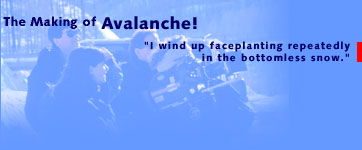
Off and Running | Preparing for the Slides
Swiss Snow Science | Fire in the Hole
Back to Montana
Sunday Feb. 2, 1997
I'm in a taxi heading for the airport, on a return trip to Montana to capture
mid-winter conditions with the forecasters and the Montana State University
(MSU) researchers. The weather continues to bring snow to the northern Rockies,
and we are hopeful that our timing is right. The cell phone rings, and it is
Karl Birkeland from the Avalanche Center. We are supposed to meet tomorrow to
discuss a sequence on snow that we will film the next day. There is a bit of a
change in plans.
A snowmobiler has been caught in an avalanche. Karl is going to the scene of
the accident tomorrow, and we are invited to tag along. Karl doesn't have all
the details yet, but the victim was almost completely buried, was pulled out by
his companions not breathing and was resuscitated using CPR. Karl plans to go
to the site and see if he can figure out what happened. He learns something
from every avalanche he gets to look at. This sounds like a good opportunity
to film a segment on the anatomy of an accident, but the logistics—transportation, getting the crew prepped, snowmobiles—will all have to be
worked out while we are enroute.
Monday Feb. 3
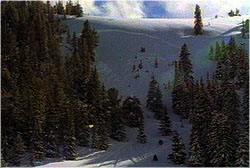 We meet at Karl's office at 7:30 am. He has arranged for a couple of
snowmobiles for our camera team. We are heading to Ennis—famous for fly
fishing—to meet up with another Forest Service Ranger, Jonathan Klein, who
has taken care of getting the other snowmobiles. The weather is clearing, and
it should be a good day to see what happened at the site. Jonathan talked to
the victim and has many more details, which he relays to us before we head to
the location.
We meet at Karl's office at 7:30 am. He has arranged for a couple of
snowmobiles for our camera team. We are heading to Ennis—famous for fly
fishing—to meet up with another Forest Service Ranger, Jonathan Klein, who
has taken care of getting the other snowmobiles. The weather is clearing, and
it should be a good day to see what happened at the site. Jonathan talked to
the victim and has many more details, which he relays to us before we head to
the location.
Two snowmobilers were 'high-marking,' a popular activity out here. Folks test
the power of their snow machines and driving ability by riding them as far as
they can up steep slopes. As they begin to lose power and traction, they steer
the machine in a big arc, the goal being to end up heading straight downhill as
fast as possible. Often they are in groups, and the idea is to be the one who
leaves the highest possible mark on the slope.
This concept of getting up to where the slope is steepest is flying in the face
of avalanche safety. Avalanches are possible on slopes anywhere from 25 to 60
degrees, and most occur on slopes between 35 and 40 degrees. By running their
machines up the hill toward the steepest part, the snowmobilers end up in
likely avalanche start zones.
Even worse, they are turning themselves into another necessary element of an
avalanche—a trigger. A trigger can be the weight of new snow falling on an
unstable slope, a skier, or a snowmobiler. When you consider the weight that a
person riding a 600-pound machine adds to a slope, it's not hard to see why
snowmobilers are likely triggers. As we head to the site of the accident, I
wonder if these snowmobilers understand the risks they are taking, or are they
oblivious to the danger, merely enjoying the game and the power of their
machines?
We travel out along 25 miles of trail. There aren't enough snow machines for
everyone to ride their own, so Kate and I are on the back. I don't have a lot
of experience with snowmobiles, but it quickly becomes clear that the more
comfortable place to ride is up front, where you can anticipate what is next
and stand up if necessary to shift your weight around. In the back, you hold
on and your butt gets kicked.
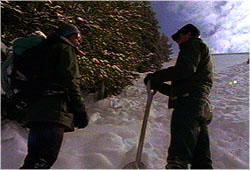 We finally arrive at the accident scene, and Jonathan and Karl investigate.
Jonathan is interested in a general sense of what happened in
the accident, while Karl is interested in the snow. Jonathan dubs Karl "Dr.
Snow," as he looks at the slope angle, gets down on bare hands to feel the snow
at the fracture line, digs a pit off to the side of the slope to see if he can
find the weak layer, and gets out a magnifying scope to get a close look at the
culprit—the snow that caused the slope to fail.
We finally arrive at the accident scene, and Jonathan and Karl investigate.
Jonathan is interested in a general sense of what happened in
the accident, while Karl is interested in the snow. Jonathan dubs Karl "Dr.
Snow," as he looks at the slope angle, gets down on bare hands to feel the snow
at the fracture line, digs a pit off to the side of the slope to see if he can
find the weak layer, and gets out a magnifying scope to get a close look at the
culprit—the snow that caused the slope to fail.
Karl gets pretty excited when he finds it: a layer of buried surface hoar—sugary, ball-bearing like snow—that is buried about a foot and a half
under the surface. In other places this sliding layer is closer to the surface,
but this slope has been loaded with snow blown in by the wind. The
wind-deposited slab of well bonded snow on top of the sugary crystals created
the dangerous, invisible conditions that nearly caused the snowmobiler to lose
his life. And the slope angle is just where one would expect it to be, at 36
degrees.
Tuesday Feb. 4
The weather is beautiful. But there is no chance of filming the MSU research
project that was scheduled for today. This project features a group from the
engineering department at MSU that set up a research facility (well, it's more
like a shack actually) in the Bridgers. Here they intentionally set off
avalanches so they can measure pressure, velocity, and density in a real
avalanche on real terrain as it flows past their shack. This data is vital to
understanding the nature of avalanches. And it is the kind of data that is
usually collected in simulated avalanche conditions. What this team wants is
to capture the data under real conditions.
But it isn't going to happen today. They need some new snow. All season long
they have had too much snow, burying their shack. In order to set up their
instruments and collect the data, they have had to dig out the avalanche path.
Usually they get the opportunity to set off about 5 avalanches a winter. This
year, they finally got it dug out last week and set one off. They managed to
collect some useful information, but needed to recalibrate their instruments
and were hoping to have another go at it today. The 8 inches of snow that fell
last Saturday would have been just right for setting off an avalanche, except
for one problem; it ran naturally.
 The snow that fell was landing on the surface hoar or sun crust from the cold,
clear weather of the previous week. The new snow didn't have anything to bond
to. So when enough of it fell, an avalanche ran. But the team wasn't there to
collect data, and we weren't there with our cameras in place. For that project
we will just have to wait for new snow.
The snow that fell was landing on the surface hoar or sun crust from the cold,
clear weather of the previous week. The new snow didn't have anything to bond
to. So when enough of it fell, an avalanche ran. But the team wasn't there to
collect data, and we weren't there with our cameras in place. For that project
we will just have to wait for new snow.
Instead, we decide to shoot some scenics of the Bridgers and the ski area. It
is a gorgeous day, and we want to make something of it. The mountains are
spectacular, and are the background for several key scenes, so it makes sense
to film them when they look so beautiful.
Wednesday Feb. 5
The clear cold weather is continuing, and we take a day off from filming. The
weather is good news for one sequence we are after, which looks like it is
coming together for tomorrow. The sequence is on Karl's research project for
his Ph.D., which we have dubbed "Snowpit Olympics." Karl is trying to get a
picture of what is going on in the snowpack over an entire mountain range on a
given day. He will do this three times over the winter, the idea being to to
try to use the data to see how accurately they can predict snow conditions
based on the variables they can measure in just one or a few pits alone.
His plan is to send out six teams of two people by helicopter, and drop them on
top of the ridge. The teams will ski down, digging six or seven snowpits along
the way. In each pit they must gather a whole slew of data, including a GPS
reading, a ram penetrometer test on the strength of various layers of the
snowpack, a stuff block measurement, and a reutchblock measurement.
Thursday Feb. 6
Heli-day!
We meet before dawn in a campground parking lot that will be a staging area for
the teams and the film crew. Karl has been waiting all season
for this, and is pretty psyched up. So are we. It looks like it is going to be
another perfect sunny day. Today this is good news. The better the weather,
the less wind, the better the flying. And the calmer the air, the better the
filming will be. Montana hasn't had much weather like this so far this season,
so we are feeling lucky. So is Karl.
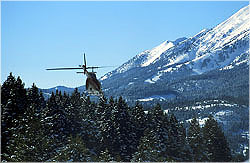 At the meeting, Karl lets his crew know that we aren't to get in the way. "Feel
free to yell at them," he says, but immediately apologizes. While he has a job
to do, he also doesn't want put us off. The helicopter arrives and team after
team is lifted off to another spot at the peak of the Bridger range. Ron and
Lee are first off. They are going to the extreme northern peaks. The heli
returns for the next team, who are going to a nearby peak. Karl and Ginger are
in the third team.
At the meeting, Karl lets his crew know that we aren't to get in the way. "Feel
free to yell at them," he says, but immediately apologizes. While he has a job
to do, he also doesn't want put us off. The helicopter arrives and team after
team is lifted off to another spot at the peak of the Bridger range. Ron and
Lee are first off. They are going to the extreme northern peaks. The heli
returns for the next team, who are going to a nearby peak. Karl and Ginger are
in the third team.
When all five teams are up it is our turn. We have agreed to pay for the
helicopter down time between the first and second lifts for the research crew.
Bob Poole, the cinematograher, is going up alone. Less weight will make the
helicopter more maneuverable. The door comes off the helicopter with the
removal of a couple of bolts, and we fashion a harness for Bob out of available
webbing and clasps. He wants to be able to lean way out to film past the bubble
the pilot has on the front of the Jet Ranger.
They take off, and all we can do is listen on the radio and make suggestions
about where to go. Forty minutes later, when Bob comes down, he is pumped. The
air was still. It really worked. We are all pretty happy. He picks up the rest
of the camera team, Dave and Kent. The three of them are going to the ridgetop
to ski down, to follow Karl and his partner as they move from pit to pit and do
their snowpack testing.
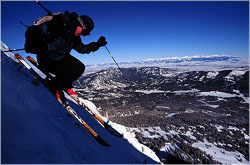 While they are up on the ridge we have arranged for them to meet Chris Stone,
the skier who was caught in the avalanche when we were here in November.
Despite Chris' potentially serious accident, he is back
chasing the powder, and we need some visuals to tell his story.
While we are filming from the helicopter, Chris' partner triggers a
small slide. No one is caught, but I have a few scary minutes on the ground
while I hear them talking back and forth on the radio about an avalanche.
Chris and his partner would probably be out skiing today even if we weren't
filming, but I can't help feeling responsible. When we are sure that no one
was hurt, the next question is, of course, did Bob get the shot? He isn't sure.
He was rolling, but the helicopter was turning away as the slide released.
We'll just have to wait and see when the film comes back from the lab.
While they are up on the ridge we have arranged for them to meet Chris Stone,
the skier who was caught in the avalanche when we were here in November.
Despite Chris' potentially serious accident, he is back
chasing the powder, and we need some visuals to tell his story.
While we are filming from the helicopter, Chris' partner triggers a
small slide. No one is caught, but I have a few scary minutes on the ground
while I hear them talking back and forth on the radio about an avalanche.
Chris and his partner would probably be out skiing today even if we weren't
filming, but I can't help feeling responsible. When we are sure that no one
was hurt, the next question is, of course, did Bob get the shot? He isn't sure.
He was rolling, but the helicopter was turning away as the slide released.
We'll just have to wait and see when the film comes back from the lab.
Saturday Feb. 8
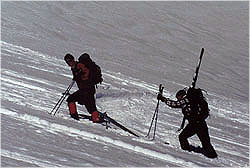 We head out with Karl and Ron on snowmobile into a beautiful bowl in the
northern Bridgers to film a scene about snow basics. These guys really are the
snow doctors. They put climbing skins on their skis and we film them climbing
up to a spot where they get can dig a snow pit. They really get out there and
touch the snow, feel it, Karl even eats it. He says you can tell what type of
crystals they are by the texture and the way they feel in your mouth.
We head out with Karl and Ron on snowmobile into a beautiful bowl in the
northern Bridgers to film a scene about snow basics. These guys really are the
snow doctors. They put climbing skins on their skis and we film them climbing
up to a spot where they get can dig a snow pit. They really get out there and
touch the snow, feel it, Karl even eats it. He says you can tell what type of
crystals they are by the texture and the way they feel in your mouth.
Sunday Feb. 9
John, the snowmobiler who was nearly died a week before, has recovered, and is
willing to return to the scene of his accident to film an interview. He is
bringing about 20 of his snowmobiling friends. My crew needs a little attitude
adjustment. I happen to have hired a group of skiers who don't have a lot of
respect for the snowmobile thing. But I encourage everyone to give it a chance.
Like it or not, snowmobiling is a winter activity whose enthusiasts are growing
by leaps and bounds. Many people do it and love it. And we are in no position
to be judgmental. If we hadn't had snowmobiles yesterday, we wouldn't have
been able to film in the glorious bowl high in the northern Bridgers. We would
have spent all day getting there, or filmed in some boring location.
So, trying to keep an open mind, we rent snowmobiles for everyone and head into
the backcountry with John, Jim, the rescuer, and a bunch of snowmobilers, many
of whom were at the scene when the accident occured.
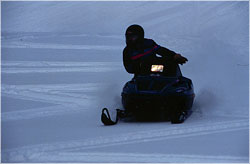 These guys couldn't be nicer or more cooperative. They go back to the scene and
check it out. They give an interview with the avalanche site still visible in
the backround. Then we ask them if we can film some visuals of them having fun,
and they go totally nuts. Everyone gets into it as they fly around on their
souped-up machines, catching air, high marking, and showing off for the camera.
I get a little worried that what Bob calls "Kodachrome courage" will get them
in trouble, but they all promise they aren't taking any chances for the sake of
the film.
These guys couldn't be nicer or more cooperative. They go back to the scene and
check it out. They give an interview with the avalanche site still visible in
the backround. Then we ask them if we can film some visuals of them having fun,
and they go totally nuts. Everyone gets into it as they fly around on their
souped-up machines, catching air, high marking, and showing off for the camera.
I get a little worried that what Bob calls "Kodachrome courage" will get them
in trouble, but they all promise they aren't taking any chances for the sake of
the film.
Tuesday Feb. 11
We're still waiting for snow for the MSU research project, so we film what we
call 'pick-ups' with Karl in his Forest Service truck. I have looked through my
script for the film, and listened to the audio tapes of what we have so far,
and realize there are a few missing links, so we get those taken care of.
Our first batch of material arrives on tape from the film lab. It is so great
to check out what we filmed last week. The scene with Karl and Jonathan that
was such a scramble looks terrific!
Wednesday Feb. 12
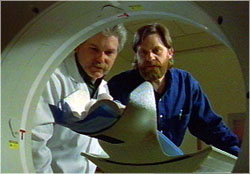 The MSU researchers have arranged to take snow samples to the hospital for a
CAT scan. They are testing this technology as a new way to look at snow and how
it bonds. We are to show up after 5 pm and hope there aren't any emergencies.
We bring in lights and look at some medical images that the technician has
stored. This machine is pretty amazing. It looks like it holds real hope for
the snow researchers.
The MSU researchers have arranged to take snow samples to the hospital for a
CAT scan. They are testing this technology as a new way to look at snow and how
it bonds. We are to show up after 5 pm and hope there aren't any emergencies.
We bring in lights and look at some medical images that the technician has
stored. This machine is pretty amazing. It looks like it holds real hope for
the snow researchers.
But then a car accident victim comes in and needs to be scanned. We wait
outside while the machine is in use, feeling a little awkward about our cameras
and lights. When the patient is moved on to be treated, we tentatively go back
to work. We are all soon caught up in looking at the snow samples. It is
after midnight by the time we call it for the night.
Thursday Feb. 13
Snow at last. Fay calls at 5 am to let us know that they will be doing control
work at Bridger Bowl, and we should come along if we want to film bombing. I
know everyone is tired from the night before, but I knock on their doors
anyway. The weather is right so we have to go for it.
That may not have been a good call, as it turns out not to be our best day.
Despite our best efforts, we seem to get in the ski patrol's way as they are
doing their bombing. We get a few good shots, but then just as Bob gets set up
to film a bomb going off on a wire, he realizes the camera battery is gone. It
fell out of a pocket somewhere in the deep powder as he skied down from a
location where he'd taken his previous shot.
Friday Feb. 14
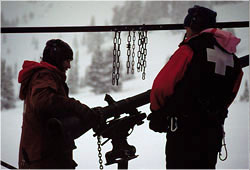 There's more snow and another chance to shoot ski area control work. This time
we are better rested. And they are going to be firing their gun today—a WWII
vintage 50mm recoilless rifle. The drill is very military, and we are
shown where it is safe to film. I've heard these guns before from a distance,
but I'm still not prepared for the concussion when they are fired. This is very cool stuff.
There's more snow and another chance to shoot ski area control work. This time
we are better rested. And they are going to be firing their gun today—a WWII
vintage 50mm recoilless rifle. The drill is very military, and we are
shown where it is safe to film. I've heard these guns before from a distance,
but I'm still not prepared for the concussion when they are fired. This is very cool stuff.
Saturday Feb. 15
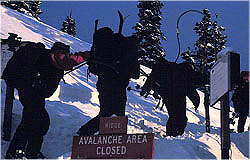 Today is one of the key days we have been waiting for. The MSU researchers are
heading up to their site. It is snowing lightly and blowing a bit, but the
forecast is for clearing weather. We meet at 6 am at the ski area. They are
going to let us ride the lifts before dawn, and then hike up the rest of the
way. They want us out of the way as early as possible.
Today is one of the key days we have been waiting for. The MSU researchers are
heading up to their site. It is snowing lightly and blowing a bit, but the
forecast is for clearing weather. We meet at 6 am at the ski area. They are
going to let us ride the lifts before dawn, and then hike up the rest of the
way. They want us out of the way as early as possible.
Dawn comes as we reach the top of the lifts and start hiking to the ridge. For
the first 400 vertical feet we travel without skis, kick-stepping into the new
snow. The researchers are allowed to ride the ski patrol's rope tow, but for
insurance reasons, the film crew isn't. So we hike. At the ridgetop, we head
north, continuing to climb, but much more gradually. We put on skis; some folks
have skins, others have telemark gear, others are side stepping it in our
downhill gear. The film crew and research team combined numbers 13. I hope this
isn't a bad sign.
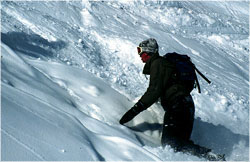 We stick together, and Scott Schmidt, who is one of the researchers, but also
on the ski patrol at Bridger, takes the lead. He warns us to stay back from
the cornices, which are big and ready to let loose. We make our way along the
ridgetop, staying within sight of each other. It is fairly exposed up here, and
the snow is still falling. It's a little scary, but very beautiful. The
visibility isn't great, but when a break comes in the clouds I get a sense of
the views from up here.
We stick together, and Scott Schmidt, who is one of the researchers, but also
on the ski patrol at Bridger, takes the lead. He warns us to stay back from
the cornices, which are big and ready to let loose. We make our way along the
ridgetop, staying within sight of each other. It is fairly exposed up here, and
the snow is still falling. It's a little scary, but very beautiful. The
visibility isn't great, but when a break comes in the clouds I get a sense of
the views from up here.
Once we are out of the ski area, we finally stop and film the trip across the
ridge. The scientists' beards are caked with snow. This is what we have been
calling the "MSU commute," and I am glad to be finally doing it.
We reach the point above the research site where we are to ski down to the
shack.
 Scott goes first to test the slope. He warns us that it is pretty loaded, and
feels a little unstable. We are all wearing avalanche transceivers, and
carrying shovels and probes. We ski each section one at a time, meeting back
up in safe zones by the trees. I have to admit to myself that I'm excited to
finally be out here, but a bit uneasy. As an eastern skier accustomed to hard
pack, with only limited experience in powder, I wind up faceplanting repeatedly
in the bottomless snow. I'm not used to being thigh-deep in this stuff, and am
embarrassed, but keep going.
Scott goes first to test the slope. He warns us that it is pretty loaded, and
feels a little unstable. We are all wearing avalanche transceivers, and
carrying shovels and probes. We ski each section one at a time, meeting back
up in safe zones by the trees. I have to admit to myself that I'm excited to
finally be out here, but a bit uneasy. As an eastern skier accustomed to hard
pack, with only limited experience in powder, I wind up faceplanting repeatedly
in the bottomless snow. I'm not used to being thigh-deep in this stuff, and am
embarrassed, but keep going.
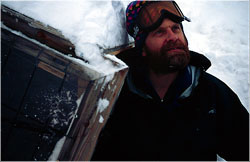 We film a brief scene of the scientists skiing down, and I feel better when Ed
Adams' faceplants too—on film. He tells me to cut that part, and his grad
students offer to pay me to keep it in. We arrive at the shack and Jim, Ed and
each of the students immediately set to work. It takes them a couple of hours
to get their computers and equipment set up for the avalanche. We have two
cameras to set up, and once we have decided on angles and loaded film, we
document the team making their preparations.
We film a brief scene of the scientists skiing down, and I feel better when Ed
Adams' faceplants too—on film. He tells me to cut that part, and his grad
students offer to pay me to keep it in. We arrive at the shack and Jim, Ed and
each of the students immediately set to work. It takes them a couple of hours
to get their computers and equipment set up for the avalanche. We have two
cameras to set up, and once we have decided on angles and loaded film, we
document the team making their preparations.
Scott makes the bomb that will set off the avalanche. He is pretty sure they
will get good results because of all the new snow, but he doesn't want to take
any chances, so he makes the bomb big enough to create a good bang. Jim and
Jay will be in the shack, and we decide to put Bob with our first camera inside
the shack as well. Kent is running our second camera, and he will be near the
shack, but off to the side of the path with Ed and the other scientists. Brian,
a film student from MSU who is also out to document the day, will be filming
from a tree at the base of the path. If his shot looks good, I will certainly
want to use it.
Once everyone is ready, and Scott heads up to set off the bomb. I have decided
to be way back in the trees with Tom. I am not going to take any chances. Kent
feels safe where he is with Ed, but just before Scott sets off the bomb, Jay
looks over and suggests that more people should be further away, just in case
something goes wrong. Just then we hear "fire in the hole" over the radio from
Scott. There is no time for anybody to move.
Ninety seconds later the bomb goes off. I see the snow above start to come
down. The powder cloud is big, and I can't see the dense part of the avalanche
as it flows below it. Everything is briefly obscured as it passes right in
front of me. Then I quickly see that Kent and Ed and the others have been
dusted by the cloud but not hit by debris. The shack, on the other hand, has
been completely buried in the snow. Usually it comes over the top, but doesn't
bury the back side. This year the snow is so deep, it has kicked back into the
shack, filling and burying it.
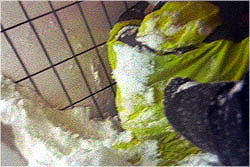 Ed and the others grab shovels to dig them out. If they are in trouble,
getting to them quickly is vital. The group in the shack doesn't answer on the
radio, but Dave Ruddick has mics in there. He indicates he can hear them and
they are OK, but they need to be dug out. I grab a shovel and start to dig too.
I'm ruining the scene, but then Dave says they are all fine. So I get out of
the way and let Kent film the digging out.
Ed and the others grab shovels to dig them out. If they are in trouble,
getting to them quickly is vital. The group in the shack doesn't answer on the
radio, but Dave Ruddick has mics in there. He indicates he can hear them and
they are OK, but they need to be dug out. I grab a shovel and start to dig too.
I'm ruining the scene, but then Dave says they are all fine. So I get out of
the way and let Kent film the digging out.
The digging only takes a couple of minutes, and once everyone is out, the
chatter starts. We are all pretty excited. Jim is saying "we definitely got
data!" Jay is happy to be freed; the snow had pinned him up against the
computer shelf in the shack. Bob is unsure what he got on film, because his
viewfinder was totally fogged. But he quickly gets back into the swing to film
the excitement of the researchers in action. I'm happy too. I know we have
Kent's angle, and hopefully Brian's. And it really was exciting to see.
We finish filming the data gathering. Time is beginning to run out. The
researchers try to retrieve a beacon they let loose in the slide, but there is
so much debris from the slide having run so large that they decide to leave it
for another day. We need to head out so that we can make it back before dark.
The skiing is fun now. The big event is in the can. We aren't trying to film
as we go, so we can relax. On the last pitch before we go past the boundary
and travel back into the ski area, I finally manage to put some good turns
together in the deep snow.
Off and Running | Preparing for the Slides
Swiss Snow Science | Fire in the Hole
Photos: (1-3, 8, 12-14) WGBH Educational Foundation;
(4, 6, 9-11) Kate Churchill/WGBH; (5, 7) Dave Ruddick.
Capturing |
Making |
Elements |
Snow Sense |
Resources
Mail |
Teacher's Guide |
Transcript |
Avalanche Home
|